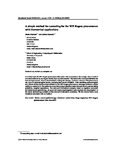A simple method for correcting for the Will Rogers phenomenon with biometrical applications
| dc.contributor.author | Stander, M | |
| dc.contributor.author | Stander, Julian | |
| dc.date.accessioned | 2019-12-07T22:32:21Z | |
| dc.date.issued | 2020-01-20 | |
| dc.identifier.issn | 0323-3847 | |
| dc.identifier.issn | 1521-4036 | |
| dc.identifier.uri | http://hdl.handle.net/10026.1/15227 | |
| dc.description.abstract |
<jats:title>Abstract</jats:title><jats:p>In its basic form, the Will Rogers phenomenon takes place when an increase in the average value of each of two sets is achieved by moving an element from one set to another. This leads to the conclusion that there has been an improvement, when in fact essentially nothing has changed. Extended versions of this phenomenon can occur in epidemiological studies, rendering their results unreliable. After describing epidemiological and clinical studies that have been affected by the Will Rogers phenomenon, this paper presents a simple method to correct for it. The method involves introducing a transition matrix between the two sets and taking probability weighted expectations. Two real‐world biometrical examples, based on migration economics and breast cancer epidemiology, are given and improvements against a naïve analysis are demonstrated. In the cancer epidemiology example, we take account of estimation uncertainty. We also discuss briefly some limitations associated with our method.</jats:p> | |
| dc.format.extent | 1080-1089 | |
| dc.format.medium | Print-Electronic | |
| dc.language | en | |
| dc.language.iso | en | |
| dc.publisher | Wiley-VCH Verlag | |
| dc.subject | breast cancer epidemiology | |
| dc.subject | historical control bias | |
| dc.subject | stage migration | |
| dc.subject | Will Rogers phenomenon | |
| dc.subject | zero-time shift | |
| dc.title | A simple method for correcting for the Will Rogers phenomenon with biometrical applications | |
| dc.type | journal-article | |
| dc.type | Journal Article | |
| plymouth.author-url | https://www.webofscience.com/api/gateway?GWVersion=2&SrcApp=PARTNER_APP&SrcAuth=LinksAMR&KeyUT=WOS:000508346400001&DestLinkType=FullRecord&DestApp=ALL_WOS&UsrCustomerID=11bb513d99f797142bcfeffcc58ea008 | |
| plymouth.issue | 4 | |
| plymouth.volume | 62 | |
| plymouth.publication-status | Published | |
| plymouth.journal | Biometrical Journal: journal of mathematical methods in biosciences | |
| dc.identifier.doi | 10.1002/bimj.201900199 | |
| plymouth.organisational-group | /Plymouth | |
| plymouth.organisational-group | /Plymouth/Admin Group - REF | |
| plymouth.organisational-group | /Plymouth/Admin Group - REF/REF Admin Group - FoSE | |
| plymouth.organisational-group | /Plymouth/Faculty of Science and Engineering | |
| plymouth.organisational-group | /Plymouth/REF 2021 Researchers by UoA | |
| plymouth.organisational-group | /Plymouth/REF 2021 Researchers by UoA/EXTENDED UoA 10 - Mathematical Sciences | |
| plymouth.organisational-group | /Plymouth/REF 2021 Researchers by UoA/UoA10 Mathematical Sciences | |
| plymouth.organisational-group | /Plymouth/Users by role | |
| plymouth.organisational-group | /Plymouth/Users by role/Academics | |
| dc.publisher.place | Germany | |
| dcterms.dateAccepted | 2019-11-18 | |
| dc.rights.embargodate | 2021-1-19 | |
| dc.identifier.eissn | 1521-4036 | |
| dc.rights.embargoperiod | Not known | |
| rioxxterms.versionofrecord | 10.1002/bimj.201900199 | |
| rioxxterms.licenseref.uri | http://www.rioxx.net/licenses/all-rights-reserved | |
| rioxxterms.licenseref.startdate | 2020-01-20 | |
| rioxxterms.type | Journal Article/Review |


